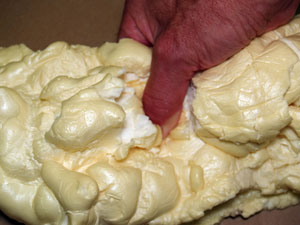In Business Since | License #
In Business Since | License #


Open cell foam is spongy and light. It resists air leakage but allows moisture vapor to pass through.
Open-cell spray foam insulation is light and sponge-like. The cells from which it is made break or pop as the foam expands and before it sets. Consequently, most cells are "broken" or open. (Think "kitchen sponge" but much smaller.) Like closed-cell insulation, it serves as an air barrier but unlike closed-cell foams, it allows water vapor to enter and pass through it.
Open-cell spray foam is light, typically only 0.4 to 0.5 lb. per cubic foot, and therefore does not substantially affect structural loads. It is generally considered more environmentally friendly than other foams because water is used as the blowing agent. In addition, open-cell foam provides excellent sound control.
To discover how open-cell spray foam would affect your home, let the experts at Dr. Energy Saver inspect your home and walk you through the process. Contact us today to get started!
Open-cell spray foam is mixed from two components. Because of its low density, it can fill much larger areas with less material than closed-cell foams. In fact, a container of open cell foam will fill 3 or 4 times more volume than a container of closed-cell spray foam. The R-value for open-cell spray foam at 3.5 to 4 per in. is significantly lower than it is for closed-cell foams. On a cost-per-R basis, however, it is less expensive.
Manufacturers of both open- and closed-cell foams have been working to make their products more environmentally friendly in recent years. Several include agricultural-based materials, such as soy oil, in their formulations – but the percentages currently remain low. In general, open-cell foam insulation is considered the greener foam insulation product because the blowing agent is water, which does not contribute to global warming. Closed-cell foams, with chemical blowing agents, have a much higher global warming potential (GWP).
| Advantages | Disadvantages |
|
|
If you're interested in open-cell spray foam applications, Dr. Energy Saver is here to help. Contact your local dealer today to get your insulation under way!
Looking for a price? Get a no cost, no obligation free estimate.